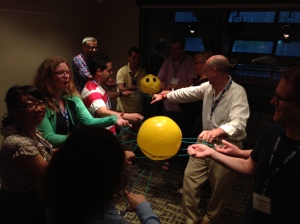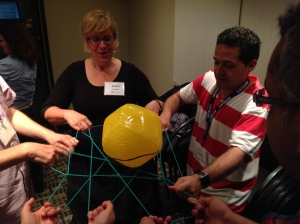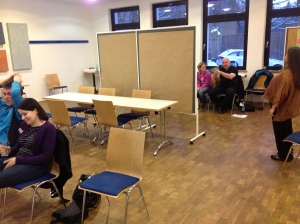Doing Trumps Reading: Training from the Back of the Room Workshop June 5-6 2014
Posted: May 4, 2014 Filed under: Agile, Agile Coach Camp, Games, Training from the Back of the Room Leave a commentWhat’s the best training experience you’ve been in? Take a moment to put yourself through the retrospectoscope and consider what made it memorable for you.
Maybe it was a Scrum training. Or a ski lesson. Or perhaps a first aid class. I’m willing to bet that whatever type of training it was, you’re not fondly recalling sitting in a beige room being talked at or PowerPointed to death. What I remember vividly from a long-ago Scrum training is not the words of wisdom falling from the instructor’s lips, but rather the games, exercises, and conversations with other participants that illustrated and reinforced the ideas being presented.
In Training from the Back of the Room, Sharon Bowman has distilled and shared a powerful framework for designing and delivering training experiences to adults that will help make learning stick. The Training from the Back of the Room approach is grounded in 6 simple principles (Sharon calls them the Six Trumps) derived from what we know about how the brain actually works to receive and retain information:
- Writing trumps reading
- Talking trumps listening
- Different trumps same
- Moving trumps sitting
- Images trump words
- Shorter trumps longer
None of these principles are revolutionary – yet we often fail to apply them when designing training experiences because they don’t align to what we’ve experienced in the past as a model of “how adult learning is done”.
I’d read Training from the Back of the Room a while back and had attempted to apply the principles in the workshops that I deliver to my clients, but it didn’t really all come together for me until I took Sharon’s class last December. For me, the workshop was a transformative experience: while I didn’t burn all my slide decks after taking the course (because there’s useful content in there that I can repurpose to be presented in different ways) I will never again deliver training the way I used to. A couple of weeks ago, I delivered a 3 day Agile team workshop making heavy use of TBR principles and I received excellent feedback from the participants about the interactive nature of the class and the very limited use of slides. Afterwards, a couple of people in the class told me how apprehensive they’d been about having to sit through a 3day training session, and how delighted they were by how little sitting they actually did and how much fun they had while doing some serious learning and planning.
If you’re interested in learning how to make Training from the Back of the Room work for you, I’ll be offering a 2 day Training from the Back of the Room workshop with Glenn Waters in Guelph ON on June 5-6 just before Agile Coach Camp Canada 2014. It’ll be a ton of fun, and you’ll walk away from the experience knowing how to apply the Six Trumps and 4Cs (next post!) to delivering your training content, two of Sharon’s excellent books, and a toolkit of activities and ideas that you can use right away to revitalize the training you deliver whatever the subject matter.
Building Your Dreams at Agile India 2014
Posted: March 8, 2014 Filed under: Agile, Games, Lego Serious Play | Tags: Agile, Agile India 2014, Lego Serious Play Leave a commentI had a great time presenting a User Requirements with LEGO Serious Play workshop at Agile India 2014. Sharing LSP with a new crowd is always fun, and the 100+ people who participated were enthusiastic and ready to play!
One lovely surprise from my session was the amazing graphic summary Lynne Cazaly created:
I think Lynne’s graphic is a better summary than my slides, but here they are anyhow:
If you’re curious to learn more about how LEGO Serious Play can help your team get work done or move forward in resolving a serious issue, check out my previous post on Why Serious Play Works or leave me a note in the comments so that we can chat.
The Team Responsibility Game
Posted: September 19, 2013 Filed under: Agile Coach Camp, Games, Play4Agile, Teams Leave a comment
I love games for learning – playing about serious matters allows people to drop some of the filters and barriers that may unconsciously affect how group discussions unfold and really explore ideas. And the laughter and drama of playing a game that involves body, mind and emotions in order to learn about something helps ensure that the learnings stick.
At Play4Agile 2013, Markus Wittwer led an amazing and very popular game about team responsibility that explores the importance of shared intentions and playfully illustrates some of the effects of dysfunctional team behaviour. I ran the same game during the Friday night playdate at Agile Coach Camp Canada 2013, where the participants had a lot of fun and made several excellent suggestions for how to extend and improve it. Since then, I’ve been asked to share the exercise so that others can run it with their teams – here you go:

Time required: 15-20 min
Number of players: teams of 7, the more teams the better
Materials:
- big loops of rope – I bought 20M hanks of lightweight cord at a dollar store and cut it into ~6.5M long pieces. For bigger groups, you may want longer loops.
- beach balls – or other light balls (balloons, playground balls) roughly the size of a soccer ball.
The game:
- Participants arrange themselves into teams of 7 and each person grabs onto the loop with two hands. The team members should count off so that they know who is team member #1, team member #2,…through to team member #7
- Each team make a net with the loop by passing the rope to each other until a net is formed.
- Place a ball in the middle of each team’s net. The team’s work is to keep the ball in play on the net – don’t let it fall!
- The facilitator then guides the team through a number of actions/scenarios. In each scenario, the team follows the instruction and attempts to move gently around the room while keeping the ball in play. The facilitator may ask the team to return to a neutral state between scenarios (or not!):
- the team moves around, learning to keep the ball in play
- team member 1 takes 130% of the responsibility by pulling harder on the cord.
- team member 2 gives up some responsibility by loosening their grip on the cord.
- team members 3 & 6 have a conflict and try to pull apart while maintaining their grip on the net.
- team member 4 leaves their home team and joins another team
- team members 5 & 7 swap places
- multi-tasking!: have one team member join onto another team while remaining part of their home team
- remote team member: have one team member close their eyes
- have the team members move around silently
- have one team member remain immobile while the rest of the team moves around.
The debrief:
This is a really powerful game for dramatizing what happens when teams are not aligned in intent or are in a position where team members are distracted from the shared team goal by external factors. I think it works best if you debrief as you go: run one or two scenarios, then pause and encourage participants to reflect on how they are feeling right then, and how the current situation reflects circumstances that are present on their teams.
Steward the living instead of managing the machine: Management 3.0
Posted: April 1, 2013 Filed under: Agile, Games, Leadership | Tags: Agile, complexity, eyestalks, Management 3.0 Leave a comment “..the role of leaders should include the stewardship of the living rather than the management of the machine.” Stoos NetworkManagement 3.0 is a class for people interested in bettering the practice of management in their organizations. It’s based on Jurgen Appelo’s very popular book, which examines the kind of management thinking and doing needed to support complex and nonlinear work, such as — but certainly not limited to — Agile software development practices. Supporting the evolution of self-organizing high-performance teams calls for a different approach to managing people than that which is typically encouraged through organizational culture, training, and change management practices. The Management 3.0 book and course provide a new basis for thinking about the goals and principles of management as well as many concrete practices that can be used to begin managing in a new way, even if your organization is just starting on a transformation to a more agile way of working.
Francois Beauregard of Pyxis Technologies brought an interesting perspective to facilitating the course material based on his experience as an Integral Development coach. In the course of exploring the Spiral Dynamics model in the first few hours of the class, we talked a lot about the importance of compassion (a word that oddly doesn’t appear in the text of Management 3.0) when assuming the responsibility for stewardship of the living in an organization. We also explored the possibilities created by differentiating between responsive and reactive behaviours.

Martie, the Management 3.0 Model
The first morning of the class was very talk-heavy, but this was balanced by the very hands-on nature of the remainder of the material, which considered each of the aspects of Martie, the six-eyed Management 3.0 model. Martie’s eyestalks each focus on one of the six views of management (Appelo specifically calls these views to reinforce the idea that these are different perspectives intertwined within a complex system rather than independent principles/concepts). We talked briefly about each view and then tried a exercise that can be used to explore how this viewpoint is instantiated in an organization. The exercises are designed to be playful and immediately useful for taking back to the office and instigating discussion: games like Delegation Poker and Meddlars provide quick ways to delve into messy issues of individual motivation or organizational transformation and to visualize complex situations so that considered action can be taken.
I particularly liked the Moving Motivators exercise, which allows people to reflect on what motivates them, and visualize how a decision or change might affect the aspects of your work that give you satisfaction. I can see this being a very useful tool in getting to know a new employee or in doing some pre-work to consider how an upcoming change may affect the morale of team members. It might also be useful as an individual exercise for examining your own motivators in the context of a work or personal situation – I may run this exercise with my teenage son to help him think through some decisions he needs to make.
All the materials from this class are easily accessible outside of the training. The content comes straight from the Management 3.0 book, and all of the exercises are downloadable from the Management 3.0 site, so there are ways to get at this goodness if you can’t get funding to attend the course. Having said that, like most good trainings I’ve attended, the greatest value is not in the material itself, but in the discussions and interactions that take place in the classroom, sharing insights and reservations about what is being presented with other interested people. The other thing to keep in mind is that while this is a management class, the content is important regardless of your role in the organization – management is by definition a 2-way relationship, and it’s important that people who work in a company understand what good management practice looks like and how their organization is designed to support (or block) it regardless of what their title might be.
Ahoy mateys: Swashbooking yer learnings!
Posted: March 23, 2013 Filed under: Agile, Games, Play4Agile | Tags: Agile, Books, Deborah Hartmann Preuss, James Marcus Bach, swashbooking 2 CommentsI firmly believe that Sunday mornings are best observed with a pot of hot coffee and a book or two to enjoy. So at Play4Agile2013 in February, on Sunday morning I pitched a Swashbooking session as one of the early slots in that day’s Open Space (though in my sleep-deprived and slightly hung-over state, I’m sure I called it ‘Bookswashing’ – I always get this backwards!). I also talked about it recently during an Agile Ottawa session as a tool for hacking your thinking, as I believe it’s a great technique for crowd-sourcing booklearning regardless of the time of day.
Swashbooking is a timeboxed approach to quickly skimming books to look for anything important, which can be practiced alone or collaboratively as part of a group. I first learned of swashbooking from Deb Hartmann Preuss (a woman who continually gets me into all kinds of good trouble), though the idea originated with James Marcus Bach, whose work as a software tester and educator has inspired me in many ways. James’ excellent book Secrets of a Buccaneer-Scholar vividly describes his experiences with hacking his own education. He has shared a video on Competitive Swashbooking capturing an 8-hour marathon wherein he and his brother Jon swashbooked their way through a diverse collection of 100+ books in order to produce a short presentation about what they learned.
Group swashbooking as I’ve practiced it is very simple:
- collect a diverse selection of books, at least one per participant. For rapid skimming, paper books offer a distinct advantage over ebooks.
- each person in the group selects a book and reads it in whatever way they prefer for a short period of time (6-10 minute timeboxes work well). The reader may read a chapter, scan the table of contents or index, flip through and look at all the illustrations — whatever works for them in finding something important in the book at hand. Recording observations as you go will be helpful, so stickies or index cards and a pen will come in handy.
- at the end of the timebox, each reader passes the book along to the next person in the group, who then reads it in whatever manner appeals to them as outlined in step 2.
- Repeat step 3 until everyone has had a chance to examine each book
- Have a short, time-boxed group discussion to share observations and impressions of the books being considered.
For a group of 5 people, the timing might work like this for a 60 minute swashbooking session:
- 5 min intro
- 30 min reading – 5 * 6 min reading sessions
- 20 min discussion – 4 min to share impressions of each book
The outcome of a swashbooking session is that all participants get a good overview of what some of the important aspects of the book might be, and have likely learned enough to make a decision of whether it’s worth digging further into a particular book.
At p4a13, the result of the session was that we all decided we really wanted to read Turn the Ship Around cover-to-cover, and there’s a plan afoot to set up a virtual Agile book salon to discuss it in a couple of months. I’ve also done this with my business partners and at other events, and in every case the participants have found the experience fun and beneficial. I can also see using this very successfully in a problem-focused situation, particularly with a diverse selection of books (bring poetry! bring picture books!) in order to stimulate creative thinking about the problem space.
If you decide to try Swashbooking, please leave me a comment letting me know how it worked for you.
Games with Distributed Teams at Play4Agile 2013: An unexpected takeaway
Posted: March 6, 2013 Filed under: Agile, Games, Play4Agile | Tags: Agile, games, Meetings Leave a commentOne of the most vivid sessions I took part in at the Play4Agile conference in Germany last month was a session on Games for Distributed Teams. Led by the amazing Silvana Wasitova, this discussion built on the preceding session about “Games in 5 Minutes” to explore how these activities can be used with distributed teams. I was hoping to get some new ideas for games to use with teams that are not colocated, since in my experience it’s rarer and rarer to find teams where everyone is located in the same city, let alone the same office. While we talked about and tried some games that could be played across a group of people connected only by a phone line*, for me the fascinating part was how this experience could also be used to demonstrate why there is really no good substitute for in-the-same-room face-time for teams that need to work together.
My discomfort started with the distributed seating arrangement in the room. Rather than arranging chairs in the usual informal circle, Silvana lined up participants along either side of the room with a row of tables in the middle. This immediately created an unsettling sense of disconnection with half of the group, though we were sitting only metres apart and could see each other clearly.
We then played a very simple name game, where each player says their name, followed by a word starting with the first letter of their name, and then the next player tags their name and word onto the name chain alternating from one side of the room to the other: “Ellen Eggplant, Sven Serendipity, Henna Hornet….”. This was easy enough when players were seated facing each other. But then we replayed the game with one row of players with their backs turned to the room, and a row of dividers down the middle to block the sightline from the other side.

The difference in the two experiences was astonishingly visceral. Firstly, the game suddenly became much harder, even though we had already had a practice round which helped with learning everyone’s names and the flow of the game. Without being able to see the other players, remembering the order of names and the second words was somehow much more difficult and the repetition of names proceeded much more slowly. The other thing that really hit home was how easy it was to disconnect from the activity once we weren’t actually looking at each other. I stood up with my iPad to take the picture of the room and because I’d already had my turn, once the picture was done it was too easy to tune out for a moment to check Twitter and email rather than attend to the game – even though we were all still in the same room, mid-session, engaging in a very brief activity. Embarrassing, but illuminating and all-too-familiar**. In the debrief afterwards, other people related experiencing a similar sense of disconnection once people in the game were no longer looking at each other throughout.
We then talked about some other ideas for games for non-colocated teams, such as the excellent on-line Innovation Games that I have used successfully for retrospectives and brainstorming when participants can’t all be in the same room. But despite all the great ideas, what I really learned from this session is how to create a simple exercise to really show team members (and their leaders) what the effects of sitting apart – even without leaving the same room – can be on intra-team communications.
________________________________________
*<rant> maybe it’s an Ottawa public-sector peculiarity, but many of the distributed teams I’ve worked with recently haven’t even had access to basic communication tools like corporate Instant Messaging or wikis, let alone high-quality video connectivity. If securing communications is an issue, perhaps IT departments should provide alternatives to using Twitter or Google Chat on personal devices for work communications?</rant>
**<rant>I spent a year working on a dispersed team for a huge multi-national project involving three different global companies where almost everyone worked from home, connecting principally by phone/email/IM. While I loved the experience for personal reasons (baths at lunchtime! jeans! flextime!), I think it was disastrous for the project in how much it slowed down getting things done. I spent almost all day on the phone dealing with things that would have taken a 10th of the time had we been colocated.</rant>


